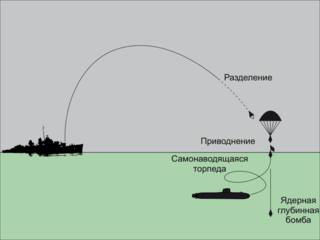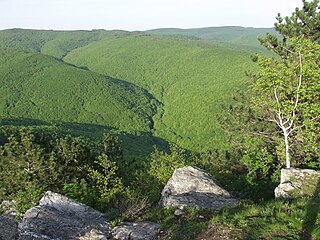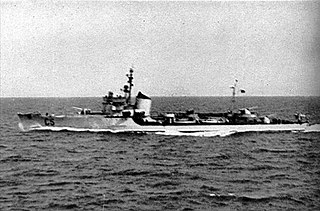
HMS Grenville was the flotilla leader for the G-class destroyers, built for the Royal Navy in the mid-1930s. She spent most of the pre-war period as part of the Mediterranean Fleet. The ship was transferred to the British Isles to escort shipping in local waters shortly after the beginning of World War II. In January 1940, Grenville struck a mine outside the Thames Estuary and sank with the loss of 77 of her crew.

The RPK-2 Vyuga, also designated as 81R, is a Soviet submarine-launched, nuclear-armed anti-submarine missile system, launched exclusively through 533-millimetre (21.0 in) torpedo tubes. The system was designed in Sverdlovsk, Russian SFSR in the 1960s.

Montenegro is a small, mountainous state in south-west Balkans. Montenegro borders Croatia, Bosnia and Herzegovina, Serbia, Albania, Kosovo and the Adriatic Sea. While being a small country at 13,812 km2, it is very diverse regarding the terrain configuration. Montenegro has 50 peaks of over 2,000m in altitude.

University of Primorska is by age and size the third university in Slovenia. It is located in Koper, Izola, and Portorož and is named for the Slovenian Littoral region, where it is located.

Papuk is the largest mountain in the Slavonia region in eastern Croatia, near the city of Požega. It extends between Bilogora to the northwest, Krndija to the east, and Ravna gora and Psunj to the southwest.

The Spica class were a class of torpedo boats of the Regia Marina during World War II. These ships were built as a result of a clause in the Washington Naval Treaty, which stated that ships with a tonnage of less than 600 could be built in unlimited numbers. Thirty-two ships were built between 1934 and 1937, thirty of which entered service with Italy and two which were sold to the Swedish Navy in 1940. The two units in Swedish service were classed as destroyers until 1953, then re-classified as corvettes. Although commonly referred to as torpedo boats due to their smaller displacement, the Spica class armaments were similar in design to destroyers, and were intended for anti-submarine duties, although they often had to fight aircraft and surface forces as well. Twenty-three vessels were lost during World War II.
German submarine U-533 was a Type IXC/40 U-boat of Nazi Germany's Kriegsmarine during World War II. The submarine was laid down on 17 February 1942 at the Deutsche Werft yard at Hamburg as yard number 351, launched on 11 September 1942 and commissioned on 25 November 1942 under the command of Kapitänleutnant Helmut Hennig. After training with the 4th U-boat Flotilla in the Baltic Sea, U-533 was transferred to the 10th flotilla for front-line service on 1 May 1943, and sunk in the Gulf of Oman on 16 October with one survivor.

The Coastal–Karst Statistical Region is a statistical region in southwest Slovenia. It covers the traditional and historical regions of Slovenian Istria and most of the Karst Plateau, which traditionally belonged to the County of Gorizia and Gradisca. The region has a sub-Mediterranean climate and is Slovenia's only statistical region bordering the sea. Its natural features enable the development of tourism, transport, and special agricultural crops. More than two-thirds of gross value added are generated by services ; most was generated by activities at the Port of Koper and through seaside and spa tourism. The region recorded almost a quarter of all tourist nights in the country in 2013; slightly less than half by domestic tourists. Among foreign tourists, Italians, Austrians, and Germans predominated. In 2012 the region was one of four regions with a positive annual population growth rate (8.1‰). However, the age structure of the population was less favourable: in mid-2013 the ageing index was 133.3, which means that for every 100 inhabitants under 15 there were 133 inhabitants 65 or older. The farms in this region are among the smallest in Slovenia in terms of average utilised agricultural area per farm and in terms of the number of livestock on farms.

The 2nd Asian Beach Games were held in Muscat, Oman from 8 December 2010 to 16 December 2010. The opening ceremony was held in the Al-Musannah Sports City, Muscat.
Friedland is an Amt in the Mecklenburgische Seenplatte district, in Mecklenburg-Vorpommern, Germany. The seat of the Amt is in Friedland.
Nicolò Vittori was an Italian rower who competed in the 1928 Summer Olympics and in the 1936 Summer Olympics.

Belgramoni–Tacco Mansion is a mansion in the city of Koper, in southwestern Slovenia. It was built around 1600. It features elements of Renaissance and Baroque, but in general has been regarded as a Mannerist building. The mansion currently serves as the seat of the Regional Museum of Koper. It is protected as a cultural monument of local significance.

Haliaetum was a Roman port that stood in the area of Simon Bay, next to the modern village of Jagodje, on the northern Adriatic coast of the Istrian peninsula. Remains visible at extreme low tide include parts of its pier as well as various port buildings. Some excavations have been carried out in recent years, with more excavations planned in the future. The site is also open to tourists. The port was first established around 178–177 BC following fierce resistance by the Histri, the indigenous population. It gave name to St. Mary of Haliaetum Church in Izola, the coastal town just southwest of Jagodje. It was erected in the 11th century and was later redesigned in the Baroque style.
Batkachny Island is an island in the Caspian Sea. It is located right off the mouths of the Volga in an area where there are many delta islands.
Holendry Kuźmińskie is a village in the administrative district of Gmina Kozienice, within Kozienice County, Masovian Voivodeship, in east-central Poland. It lies approximately 8 kilometres (5 mi) north of Kozienice and 73 km (45 mi) south-east of Warsaw.
SM UB-22 was a German Type UB II submarine or U-boat in the German Imperial Navy during World War I. The U-boat was ordered on 30 April 1915 and launched on 9 October 1915. She was commissioned into the German Imperial Navy on 2 March 1915 as SM UB-22. The submarine sank 27 ships in 18 patrols for a total of 16,645 gross register tons (GRT). UB-22 was mined and sunk in the same incident with the torpedoboat SMS S16 in the North Sea at 54°40′N6°32′E on 19 January 1918 in a British minefield.

Slovene Istria is a region in southwest Slovenia. It comprises the northern part of the Istrian peninsula, and it is part of the wider geographical-historical region known as the Slovene Littoral. Its largest urban center is Koper. Other large settlements are Izola, Piran, and Portorož. The entire region has around 120 settlements. In its coastal area, both Slovene and Italian are official languages.

The Monts du Lyonnais are a range of low-altitude mountains and eastern foothills of the Massif Central located in the Loire and Rhône departments in France.

The Slovene Riviera is the coastline of Slovenia, located on the Gulf of Trieste, by the Adriatic Sea. It is part of the Istrian peninsula and is 46.6 km long. The region comprises the towns of Koper and Piran with Portorož, and the municipality of Izola. It is a seaside tourist destination, with a vibrant multiethnic Slovenian and Italian heritage.